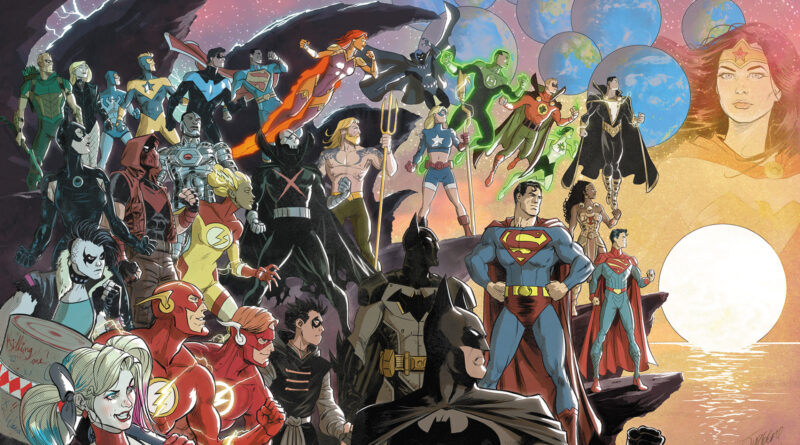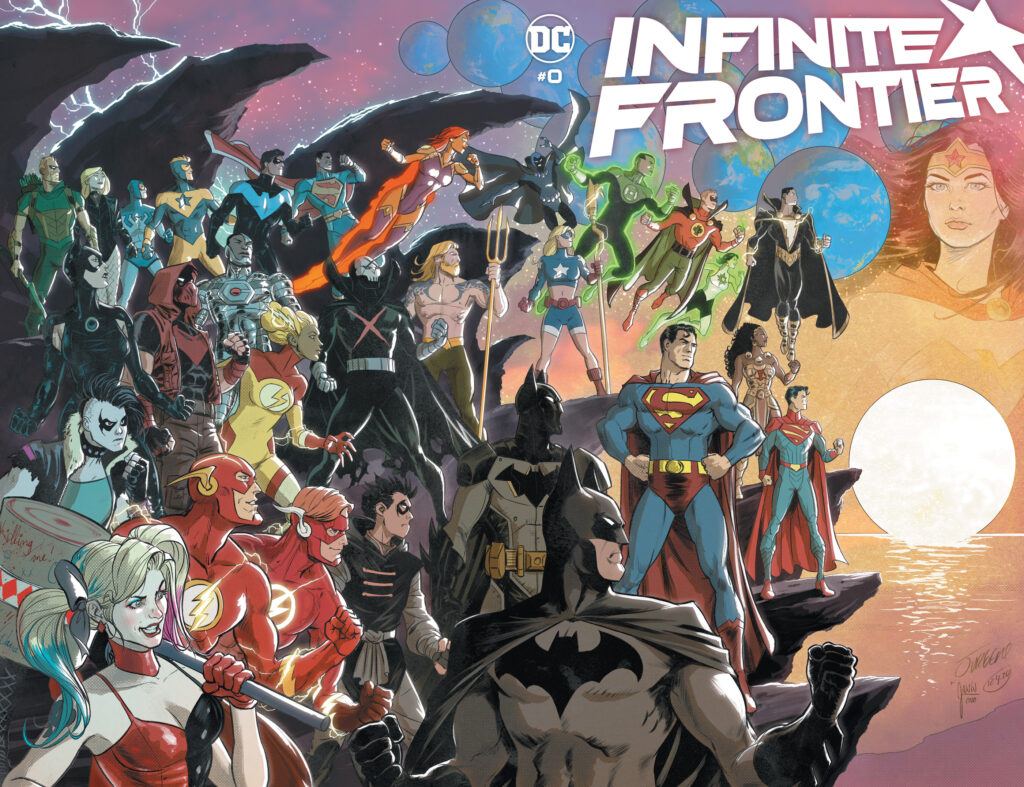
Comics Corner – Infinite Frontier establishes DC’s gay past and queer future
In the DC Universe, the only constant is change. The main continuity of the superhero publisher has been rebooted no less than nine times since 1986’s Crisis on Infinite Earths, with follow-up events Zero Hour, 52, Infinite Crisis, Final Crisis, Flashpoint, Rebirth, Dark Knights: Metal, and Dark Knights: Death Metal all re-stitching the fabric of the fictional universe – and if the Watchmen crossover Doomsday Clock proves to ‘count’ in the grand scheme of things (it might not, because of very complicated reasons) that’ll be an even ten major cosmic re-workings.
The most recently concluded of those events – Dark Knights: Death Metal – has given way to a new landscape where DC’s temporarily erased past has been restored, with legacy characters taking up decades-old mantles in the present, and setting the stage for millennia of heroes to come in the future. This new world is established in last week’s Infinite Frontier #0 – and it promises even more LGBTQ+ representation in DC’s roster going forwards.

The comic itself is essentially an anthology, with a framing sequence – written by Joshua Williamson, James Tynion IV, and Scott Snyder, with art by John Timms and Alex Sinclair – following Wonder Woman after her transition to a more cosmic position in the wake of Death Metal. Travelling unseen across the DC universe, before possibly ascending to a state of godhood herself, she checks in on friends and allies alike.
Many of the segments serve chiefly to set up the status quo for various characters and stories going forwards – the Batman segments, for instance, establish an attack on Arkham Asylum that wipes out almost all the residents, criminals and doctors alike. Similarly, a lead-in to the upcoming Justice League run sees Superman encounter a seemingly penitent Black Adam (regrettably nicknamed “Shazadam” here, which hopefully will not stick) on a path to redemption.
However, it’s a section centred on the original Green Lantern, Alan Scott, that’s likely to be the hallmark of the comic for LGBTQ+ readers. In a four-page spread written by Tynion IV, with art by Stephen Byrne, the classic hero is not only re-established as a primary figure in the history of the DC Universe, but confirmed to be gay.

We’ve explored the complicated history of Alan Scott in Comics Corner before, but to briefly recap, the character – who first appeared back in 1940 – was re-imagined as a gay man a decade ago, in a series called Earth 2, set in an alternate universe. The Green Lantern 80th Anniversary Special, published in June 2020, laid the groundwork for Alan’s return in the ‘main’ DC Universe, with a story (also written by Tynion IV) that merged the veteran 1940s hero with the modern gay take on the character from Earth 2. At the time, we wondered if the plan was to have Alan be bisexual, but Infinite Frontier takes things in a different direction.
In an emotional and difficult conversation with his children Jennie-Lynn and Todd, AKA second generation superheroes Jade and Obsidian, Alan confesses that he’s been hiding a part of himself for decades. It was a part that he ignored in favour of burying himself in work and the responsibilities of being Green Lantern. Now, with an important new role ahead as a sentinel protecting the world, he feels he needs to be finally true to himself.

Interestingly, the section is narrated by Obsidian, who himself came out as gay in 2006, in the pages of Manhunter. Having come out before his father, it’s Todd that helps Alan finally get the words out and say “I’m gay”. It provides a nice role reversal, with the younger hero supporting and guiding the elder statesman.
While it’s slightly disappointing that DC hasn’t established Alan as a bisexual hero – bi men have catastrophically low levels of positive representation in mass media – the reveal of the core continuity version of Alan Scott as gay is rather elegant. It maintains the gay representation of the Earth 2 take on the character, while keeping the long history of the character intact. Tynion IV doesn’t erase Alan’s established previous relationships or marriages to women – Alan says he let himself “get married a few times to women I did love with all my mind”; that latter comment, ‘mind’ not ‘heart’, a beautiful, subtle, and slightly sad distinction – and maintains the continuity point that Alan didn’t even know about Jennie-Lynn and Todd’s existence until they were adults. The exchange also establishes that Alan quietly told some of his allies in the Justice Society – a World War II era team of superheroes – decades before, which offers opportunity for future stories to explore the reality of being a closeted gay man in earlier eras. The twist of one of the world’s most powerful heroes protecting people he knows would reject the truth of him is one ripe for exploration.
Perhaps most interestingly, Alan’s new status provides readers with a rare example of an older gay hero – a rarity in and of itself, let alone one dealing with coming out later in life. How Alan deals with his newly open existence, and perhaps more interesting, how his peers react, lays the groundwork for fascinating stories to come.

Infinite Frontier isn’t just a lens into DC’s queer past though – other areas hint at other LGBTQ+ heroes we’ll be seeing more of in coming months. A short written and drawn by Joëlle Jones, with colour art by Jordie Bellaire, focuses on new character Yara Flor – who, readers of the recent Future State series will know, grows up to be the next Wonder Woman. In that possible future, Yara ventured into the underworld to rescue the soul of a fellow Amazon she seemed remarkably close to – close enough to literally walk into hell for. Yara will be seen next in a new Wonder Girl series, launching in May, so it’ll be there any relationships for her are explored.
Meanwhile, the lead-in to a new Teen Titans Academy doesn’t reveal much beyond the introduction of a new generation of young heroes set to trained by the original Teen Titans. However, teen-focussed comics tend to be where new LGBTQ+ characters are introduced, making this a book to keep an eye on.
With other recent comics introducing a non-binary Flash, and the brilliant new Green Lantern Jo Mullein, whose queer identity is shown in Far Sector, set to take a more prominent role going forward, Infinite Frontier helps pave the way to a brighter, more inclusive and representative future for DC – and that’s something every LGBTQ+ comics fan should be pleased about.












